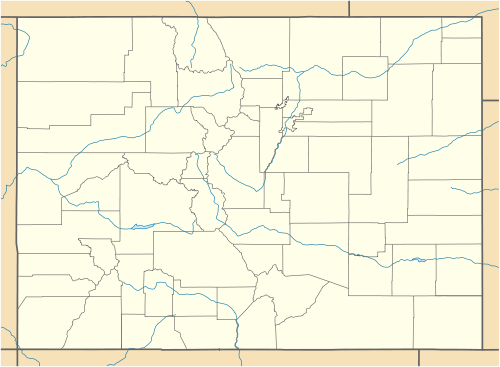Fort Lyon
|
Fort Lyon | |
|
One of the Fort's main buildings in 2013. | |
  | |
| Location | Bent County, Colorado |
|---|---|
| Nearest city | Las Animas |
| Coordinates | 38°04′27″N 103°07′57″W / 38.07417°N 103.13250°WCoordinates: 38°04′27″N 103°07′57″W / 38.07417°N 103.13250°W |
| Built | 1867 |
| Architect | U.S. Army; et al. |
| Architectural style | Colonial Revival, Bungalow/Craftsman |
| NRHP Reference # | 04000388[1] |
| CSRHP # | 5BN.117 |
| Added to NRHP | May 05, 2004 |
Fort Lyon, first named Fort Wise, has served in Colorado as a United States Army fort, a sanatorium, a neuropsychiatry facility, and a minimum security prison. The state closed the prison in 2011, and in early 2013 proposed to use the site as a rehabilitation center for homeless people. Then in late 2013 became a rehabilitative transitional housing facility for homeless people with some form of substance abuse problem(s). This is run by the Colorado Coalition for the Homeless and has been a developing program to current day.
The fort is listed on the National Register of Historic Places.
Part of the site, the Fort Lyon National Cemetery, which began burials in 1907, remains open.
History
Fort Lyon was operated on the Colorado eastern plains until 1867. That year a new fort called Fort Lyon, and later Las Animas, Colorado, U.S. Naval Hospital and 5BN117, was built near the present-day town of Las Animas, Colorado. First named after Virginia governor Henry Wise, the fort was renamed in 1862 during the American Civil War. The US Army named it after General Nathaniel Lyon, who was killed in the Battle of Wilson's Creek near Springfield, Missouri in 1861.
Old Fort Lyon was notable as the staging post used by Colonel John Chivington in 1864 as he led an attack by the Third Colorado Cavalry and other forces on friendly Cheyenne and Arapaho camps that became known as the Sand Creek Massacre. As witnesses and survivors emerged, the US Congress investigated, with a resulting national wave of public outrage about the slaughter and mutilation of up to 163 people, primarily women, children, and the elderly. The campground has been designated a National Historic Site.
In 1866 after flooding on the Arkansas River, the US Army established a new fort near Las Animas. The facility was completed in 1867. The U.S. Army used Fort Lyon until 1897, when they abandoned it after the end of the Indian Wars.
In 1906, the U.S. Navy opened a sanatorium there to treat sailors and marines with tuberculosis. The dry climate and rest by isolation at the fort were thought to be beneficial by contemporary treatment methods. On June 22, 1922, the Veteran's Bureau assumed operations. In 1930, administration of the hospital was transferred to the newly created Veterans Administration. Within three years, the VA designated Fort Lyon a neuropsychiatry facility.
In 2001 the hospital was closed and the facility was turned over to the state of Colorado for conversion to a minimum security prison. The prison was closed in 2011.
In September, 2013, Governor John Hickenlooper announced that Fort Lyon had reopened as an isolated rehab facility for homeless people with substance abuse issues[2] operated by the Colorado Coalition for the Homeless.[3][4]
See also
References
- ↑ National Park Service (2008-04-15). "National Register Information System". National Register of Historic Places. National Park Service.
- ↑ Gov. Hickenlooper applauds reopening of Fort Lyon as innovative homeless recovery opportunity. Press release, Sept. 3, 2013.
- ↑ Lydia DePillis (August 8, 2014). "Why Denver is trucking its homeless to the middle of nowhere". The Washington Post. Retrieved January 18, 2015.
Early indicators of success aside, the reason the program at Fort Lyon exists is because of failure. For about 80 years, the former military base had been a neuropsychiatric facility for traumatized veterans, but closed in 2001 after proving too expensive to operate. After that, the state Department of Corrections turned it into a minimum security prison, but that folded in 2011 after transportation costs got too high, since medical specialists are so far away. Finally, Bent County partnered with the Colorado Coalition for the Homeless to create a kind of treatment that would remove people from everything that had enabled their addiction in the first place, and stay there for an extended period of time...
- ↑ Tom McGhee (August 20, 2014). "Controversial Fort Lyon homeless facility sends alums into world". The Denver Post. Retrieved January 18, 2015.
For the 202 residents, who may stay from 90 days up to two years, the graduations are an encouraging sign that the shelter's remote location and array of services will, over time, reduce homelessness in the metro area, said Joseph Parvensky, president of the Colorado Coalition for the Homeless, which administers the program.
Further reading
- Roe, Frances Marie Antoinette Mack (1909). Army letters from an officer's wife, 1871-1888. D. Appleton.Available online, Washington State Library's Classics in Washington History collection. In 1871, Frances M.A. Roe accompanied her husband, Lieutenant Colonel Fayette Washington Roe (1850–1916), to his assignment at Fort Lyon, Colorado Territory. In this collection of letters, she describes their experiences while stationed at the fort.
